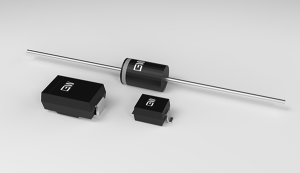A transient voltage suppressor or TVS is a general classification of electronic components that are designed to react to sudden or momentary overvoltage conditions. One such common device used for this purpose is known as the transient voltage suppression diode, a Zener diode designed to protect electronics device against overvoltages. Another design alternative applies a family of products that are known as metal-oxide varistors (MOV).
The characteristic of a TVS requires that it respond to overvoltages faster than other common overvoltage protection components such as varistors or gas discharge tubes. This makes TVS devices or components useful for protection against very fast and often damaging voltage spikes. These fast overvoltage spikes are present on all distribution networks and can be caused by either internal or external events, such as lightning or motor arcing.
Applications of transient voltage suppression diodes are used for unidirectional or bidirectional electrostatic discharge protection of transmission or data lines in electronic circuits. MOV-based TVSs are used to protect home electronics, distribution systems and may accommodate industrial level power distribution disturbances saving downtime and damage to equipment. The level of energy in a transient overvoltage can be equated to energy measured in joules or related to electric current when devices are rated for various applications. These bursts of overvoltage can be measured with specialized electronic meters that can show power disturbances of thousands of volts amplitude that last for a few microseconds or less.


